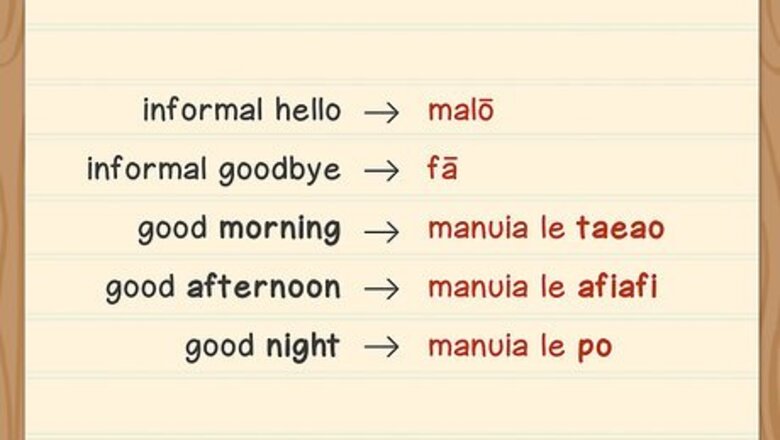
views
X
Research source
Start by learning basic words and phrases and work on your pronunciation. A bit of grammar will help you put your words into sentences!
Learning the Basics
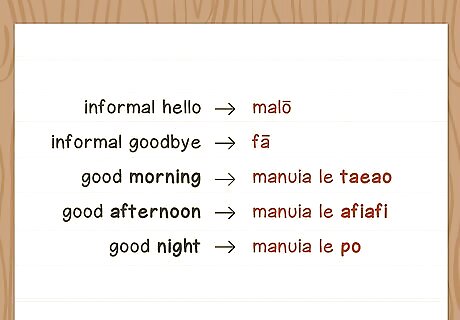
Say "malō" as an informal hello and "fā" for an informal goodbye. If you want to be more formal, you can say "malō soifua" instead for hello. Another option for a greeting is "Tālofa." For other ways to say "goodbye," try "tōfā" or "tōfā soifua." These are a bit more formal than "fā." If you want to try a time-sensitive greeting, use "Manuia le taeao," for "Good morning"; "Manuia le afiafi," for "Good afternoon"; or "Manuia le po," for "Good night."

Try some basic conversational phrases like "How are you?" In Samoan, you'd say, "Ua mai oe?" To say "I'm good, thanks," you'd reply, "Manuia fa'afetai." You can add "Ae a oe?" at the end to turn the question back to the other person. You could also try "Nice to meet you," which is "Fiafia ua ta feiloai."
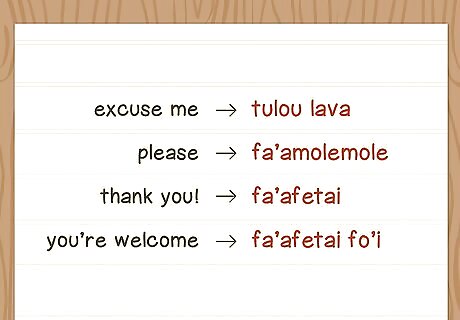
Learn the polite phrases like "Tulou lava," for "Excuse me." For please, say "Fa'amolemole." You can also try "Fa'afetai," which means "Thank you!" For "You're welcome," say "Fa'afetai fo'i."
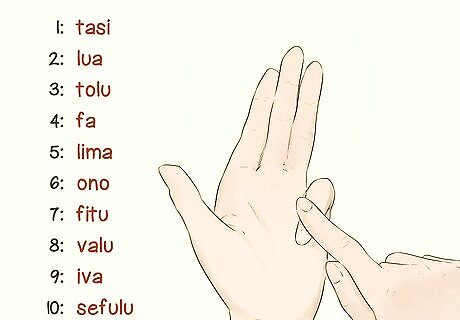
Work on your basic numbers. Start with learning 1-10. You count to 10 this way: tasi (1), lua (2), tolu (3), fa (4), lima (5), ono (6), fitu (7), valu (8), iva (9), and sefulu (10). If you want to continue to 20, count this way: sefulutasi (11), sefululua (12), sefulutolu (13), sefulufa (14), sefululima (15), sefuluono (16), sefulufitu (17), sefuluvalu (18), sefuluiva (19), and luasefulu (20). Related to numbers, if you need to ask how much something costs, say "E fia le tau?"
Working on Pronunciation
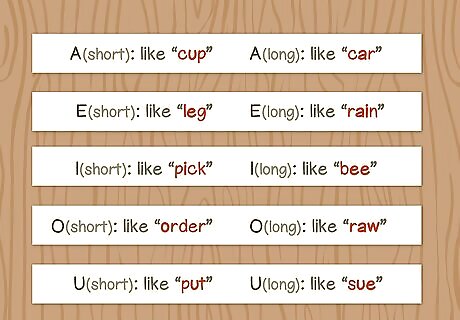
Learn the short and long sounds of the vowels. For "A," the short sound is like "cup," and the long sound is like "car." With "E," the short sound is like "leg," while the long sound is like "rain." The short sound for "I" is "pick," and the long sound is "bee." When pronouncing "O," the short sound is "order," while the long sound is similar to "raw." Finally, the short sound for "U" is "put," and the long sound is like "sue." The long sounds are marked with a line above the vowel, like this: "Ā ā."
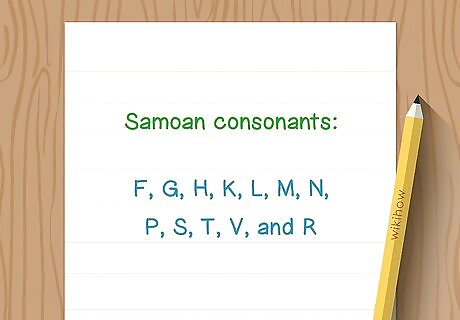
Memorize the 12 consonants Samoan uses. The Samoan language doesn't use as many consonants as English. However, with the exception of "G," they are pronounced the same way. The consonants Samoan uses are the following: F, G, H, K, L, M, N, P, S, T, V, and R. The "g" sound makes an "ng" sound, such as "sing" or "fling." K, H, and R aren't used as much as other letters; they mostly show up in words borrowed from other languages. Samoan never uses 2 consonants next to each other in a word.
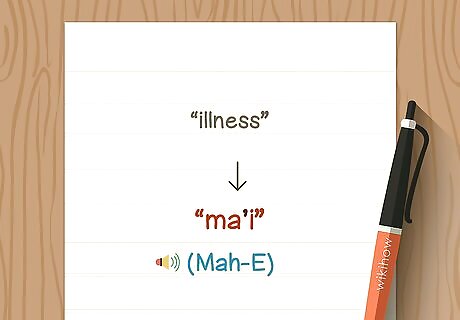
Look for the glottal stop, marked by an apostrophe. You'll notice that many Samoan words have apostrophes in the middle of them. These don't mark contractions and possessives like they do in English. Rather, it designates that there is a small pause between the vowels when you say the word. For instance, "ma'i" is pronounced "Mah-E."
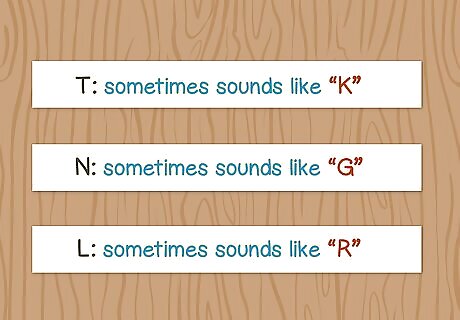
Listen for the changes in "T" and "N" in informal speech. While consonants are mostly pronounced like they are in English, they can take on a few different sounds. For instance, "T" sometimes sounds like "K" in informal speech, while "N" can sometimes take on the same sound as the "G," like the "ng" in "sing." Also, sometimes the "L" sounds like an "R."
Working on Basic Grammar
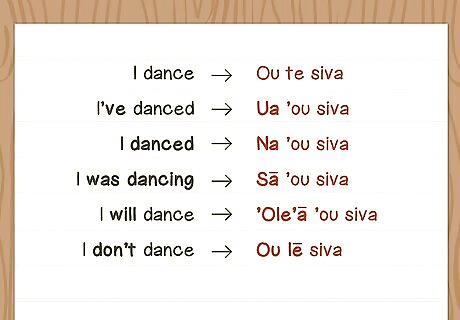
Add words like "te" to change the tense of verbs. In Samoan, verbs don't change tense. Rather, you add words to show whether you're speaking about the present, past, or future. When speaking about the present, add "te" before the verb. "Te" is the only tense that's added directly before the verb; otherwise, it comes at the beginning of the sentence. For instance, to say "I dance," you'd say, "'Ou te siva," where "Ou" is "I" and "siva" is "dance." To say "I've danced," use " 'Ua 'ou siva," where " 'Ua" is added at the beginning to make this tense. With past tense, put the extra word at the beginning of the sentence. For instance, to say "I danced," you'd write "Na 'ou siva." Similarly, to say "I was dancing," you'd write "Sā 'ou siva." The "Na" and the "Sā" place it in the past tense. For future, add " 'Ole'ā," such as " 'Ole'ā 'ou siva," meaning "I will dance." To make the verb negative, add "lē" before it: "Ou lē siva," which means "I don't dance."

Remove the article "le" to make a noun plural. Whenever a noun is used, it's assumed to be plural unless you add the word "le" before it. Therefore, if you want it to be singular, you must use the article. For instance, " 'o le tagata" is "the man" and " 'o tagata" is "men."
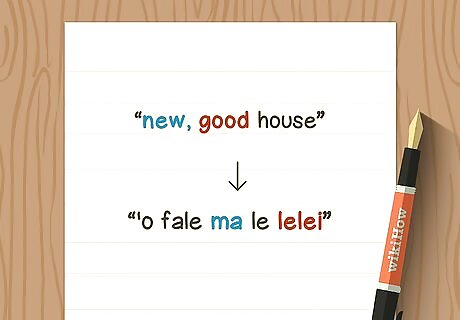
Put the adjective after the noun. Instead of the adjective coming in front of the noun as it does in English (good house), it comes after it, such as " ʻo le fale lelei" or "house good," where "fale" is "house" and "lelei" is "good." To use 2 adjectives on one noun, move the article "le" to the second adjective; it then is technically a noun. For instance, to say a "new, good house," you'd write " 'o fale ma le lelei," where "ma" is new.
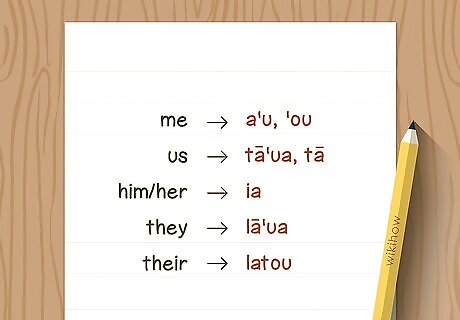
Learn the pronouns. The pronoun for "me" is "a'u," though " 'ou" is sometimes used, while "us" is "tā'ua," though "tā" is sometimes used; "our" is "la'ua." "You" singular is " 'oe" (sometimes " 'e") and plural is " 'oulua" (sometimes "lua"). For "our," use "tātou" (sometimes "matou"). For the third person "him" or "her," use "ia." "They" is "lā'ua," and "their" is "latou."
Using Other Resources

Use flash cards to build up your vocabulary. Focus on common words, like words for food, family, days of the week, and so on. Write the word out in Samoan on one side of a flash card and in English on the other side. Then practice with your flash cards to increase your vocabulary. You can also use flash card apps to do the same thing. Try labeling items in your house with the Samoan words.

Consume Samoan media. While it may be a bit more difficult to find media in Samoan than other languages, you can find videos in Samoan on websites like YouTube and other video websites. You could also try podcasts or find radio stations in Samoan over the internet. The more you listen to the language, the more you'll pick up.

Hire a tutor or take a class. You may have to go online to find a class on Samoan, but it's certainly doable. On the other hand, if you have the cash, consider hiring a tutor to teach you Samoan. One-on-one learning is a great way to pick up a language. Search online to see if there are any available tutors in your area. If not, you could see if anyone does tutoring online.

Find native speakers in your area or online to chat with. Alternatively, find people in your area wanting to learn Samoan, too. The key is to locate people who are interested in the language and willing to chat with a beginning speaker. You can use social media to find groups nearby or check for online forums and groups you can join to help you learn the language. You may even be able to find someone who speaks Samoan that wants to learn more English so you can be mutually beneficial to each other.
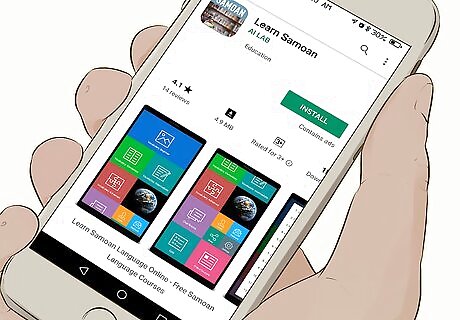
Try online games, apps, and tutorials. Just like with any language, you'll find a plethora of ways to help increase your vocabulary online. These websites and apps make learning a language into a game, so you'll be more dedicated to building your vocabulary. Search online for games to learn Samoan or check the app store on your phone.













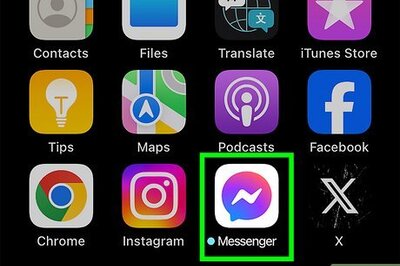
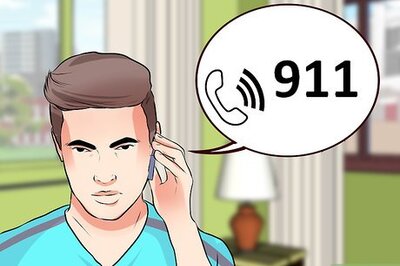
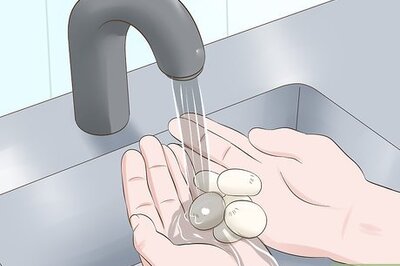

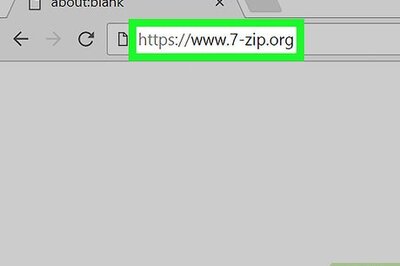


Comments
0 comment